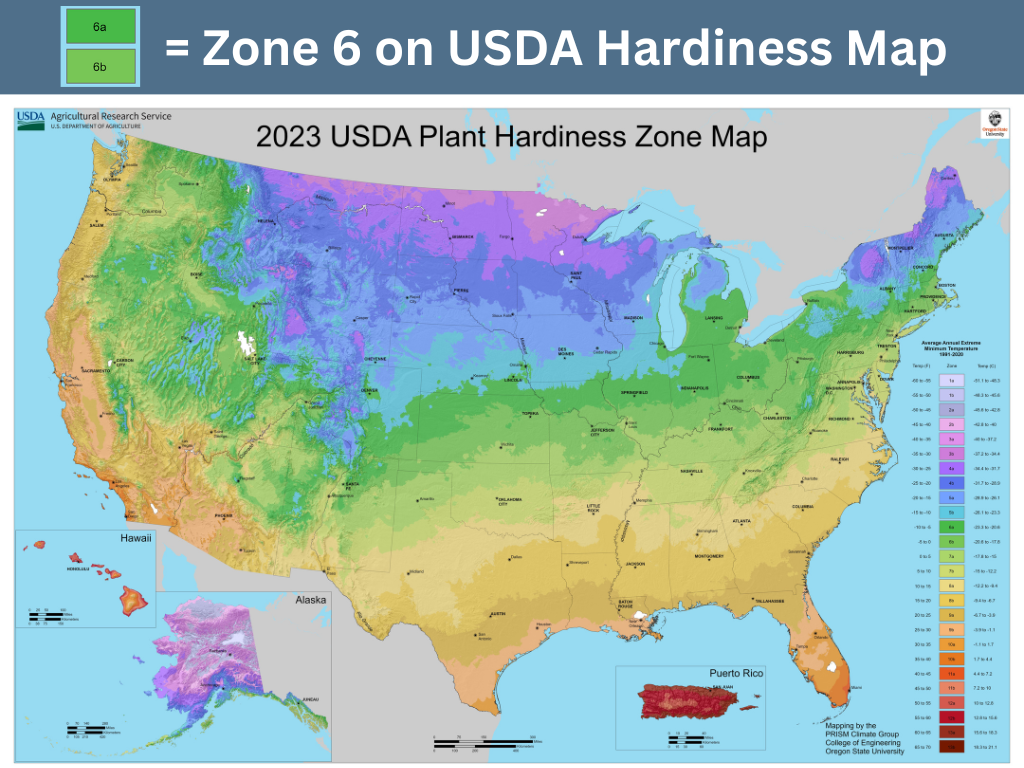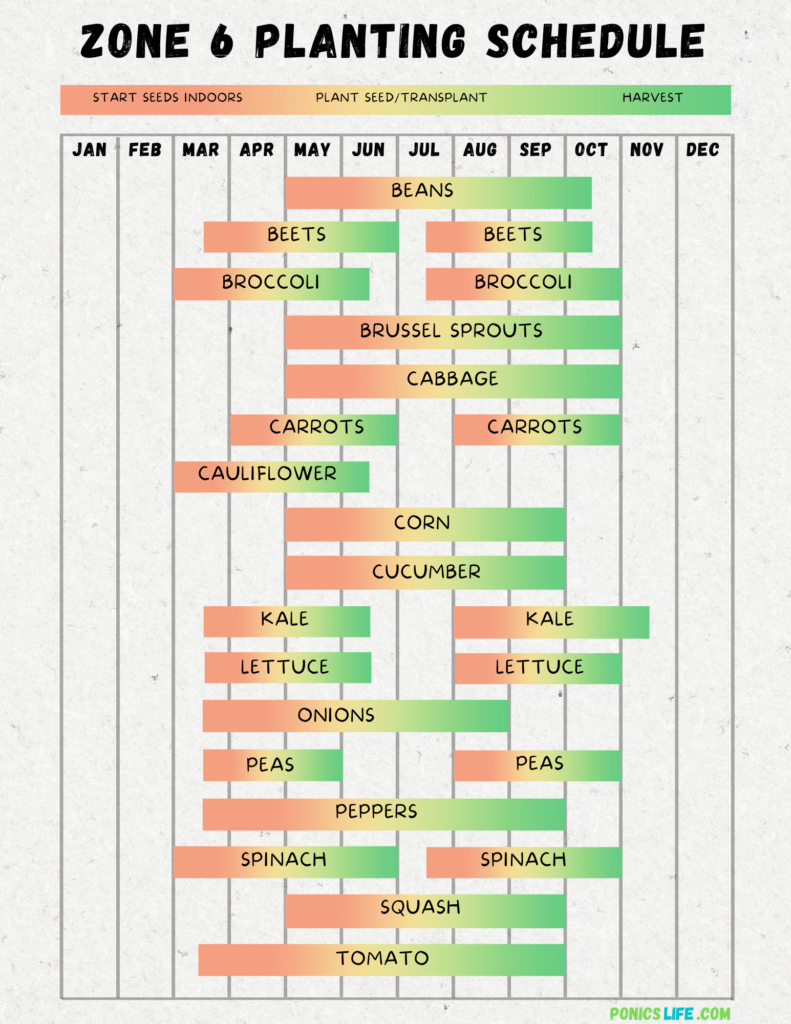“Zone 6 Planting Schedule and Calendar: A Quick Guide” offers a comprehensive look into the gardening calendar specific to Zone 6, a region with its own unique set of climatic conditions and growing challenges.
This guide is designed to demystify the timing and techniques for successful planting in this area, where the balance of cooler winters and warmer summers creates a diverse range of gardening possibilities.
From selecting the right plants to understanding the optimal times for sowing and harvesting, this quick, introductory guide and calendar is a must-read for anyone looking to maximize their gardening success in Zone 6, ensuring a lush, productive garden throughout the year.

Zone 6 Facts
- Zone 6 is designated by the USDA Plant Hardiness Zone Map, a map that categorizes regions based on their average annual extreme minimum winter temperature. This system helps gardeners and growers determine the most suitable plants for their region’s climate.
- The Map is displayed using color-coded zones, each representing a range of winter temperature averages to simplify the process of identifying the appropriate plants for a region’s specific climate conditions.
- Zone 6 is characterized by average annual minimum winter temperatures ranging from -10 to 0 degrees Fahrenheit (-23 to -18 degrees Celsius). This range creates a moderate climate that can support a wide variety of plants, including certain perennials, annuals, vegetables, and shrubs that are well-suited for these temperature conditions. The zone typically experiences distinct seasonal changes, with a noticeable transition from cold winters to warm summers, offering a diverse gardening calendar throughout the year.
- Zone 6, like other zones on the USDA Plant Hardiness Zone Map, is subdivided into two half zones: 6a and 6b. These half zones represent a finer temperature gradient, with each half zone differing by about 5 degrees Fahrenheit. This distinction allows for more precise gardening and planting strategies, as 6a and 6b indicate slightly different average minimum winter temperatures, thereby catering to the needs of plants that may require specific cold weather conditions for optimal growth.
- Zone 6a falls within (-10 to -5 °F/-23.3 to -20.6 °C) and Zone 6b falls within ((-5 to 0 °F/-20.6 to -17.8 °C)
Zone 6 Planting Schedule
Below is a Zone 6 Planting Schedule/Calendar. Use it to effectively plan your gardening activities throughout the year, ensuring that your plants are sown, transplanted, and harvested at the optimal times for their growth and productivity. This schedule will help you maximize the yield and health of your garden by aligning your gardening practices with the specific climate conditions of zone 6.

Important Note: When looking at the schedule, don’t feel that you need to be exact. Just try to stay in the general ballpark of when your vegetables are supposed to be started, transplanted, and harvested. Although this is a rough outline, it’s designed to be flexible and adaptable to your unique gardening situation, taking into account variations in local weather patterns and individual plant needs. Remember, gardening is as much an art as it is a science, so use this schedule as a guide, not a strict rulebook.
Why has Zone 6 Changed in the New USDA Hardiness Map?
The latest update to the USDA Plant Hardiness Zone Map reflects significant changes, showcasing a more detailed and accurate representation of growing climates across the United States. This new map, developed using advanced climate data collection and analysis techniques, offers a more nuanced understanding of the regional climates, particularly in terms of winter temperature averages.
One of the most notable changes in the new map is the shifting of certain areas into warmer hardiness zones. This change is a result of increased precision in temperature data and possibly reflects broader climate trends. For example, some regions previously classified in cooler zones may now find themselves in a higher zone number, indicating a warmer average minimum temperature. This shift is crucial for gardeners and agricultural planners, as it affects the selection of plants that are likely to thrive in these slightly warmer conditions.
Frequently Asked Questions
Explore our comprehensive FAQs below for valuable insights and practical tips on making the most of your garden in Zone 6.
Is the Zone 6 planting schedule relevant to outdoor hydroponic systems?
Yes, the Zone 6 planting schedule is relevant to outdoor hydroponic systems, especially when these systems are exposed to the natural climate conditions of the zone. While hydroponics allows for more control over the growing environment, outdoor systems are still subject to seasonal temperature variations and frost dates typical of Zone 6. Therefore, adhering to the Zone 6 schedule can guide hydroponic gardeners on the best times for planting and harvesting, ensuring that plants are grown during optimal outdoor climate conditions. However, for indoor hydroponic systems, the influence of external climate is minimized, offering greater flexibility in planting schedules.
When is the best time to start planting in Zone 6?
In Zone 6, the planting season typically begins in early spring, after the danger of the last frost has passed. This is usually around April, but it’s important to pay attention to local weather conditions as frost dates can vary.
What vegetables thrive in Zone 6?
Zone 6 is conducive to a variety of vegetables. Cool-season crops like lettuce, peas, and broccoli can be planted early in the spring. Warm-season crops like tomatoes, peppers, and cucumbers should be planted after the last frost, typically in late spring.
Is fall gardening possible in Zone 6?
Absolutely! Fall is a great time to plant cool-season crops like spinach and kale in Zone 6. These crops can tolerate the cooler temperatures and even taste better after a light frost.
How should I prepare my garden for winter in Zone 6?
To prepare your garden for winter, remove any dead or diseased plant material, add mulch to protect plants from freezing temperatures, and consider planting cover crops to enrich the soil.
What is the USDA Hardiness Zone Map?
The USDA Hardiness Zone Map is a tool created by the United States Department of Agriculture to categorize regions based on their average annual minimum winter temperature. It helps gardeners and growers determine which plants are most likely to thrive in their local climate.
Where can I find the full USDA Map?
If you’d like to explore the map itself, you can find it here. If you need information on how to use the map, you can find that here.
How is Zone 6 defined on this map?
Zone 6 is defined by its average annual minimum winter temperatures, which range from -10 to 0 degrees Fahrenheit (-23 to -18 degrees Celsius). This moderate climate allows for a variety of plants to be grown.
What are the sub-zones in Zone 6?
Zone 6 is divided into two sub-zones: 6a and 6b. 6a has colder winter temperatures ranging from -10 to -5 degrees Fahrenheit (-23 to -21 degrees Celsius), while 6b ranges from -5 to 0 degrees Fahrenheit (-21 to -18 degrees Celsius).
What changes does the new USDA Hardiness Map show for Zone 6?
The new USDA Hardiness Map may show shifts in the boundaries of Zone 6, reflecting changes in average minimum winter temperatures. This could mean certain areas moving into Zone 6 from either warmer or colder zones, indicating a change in their climate profile.
How should gardeners in Zone 6 use the Hardiness Map?
Gardeners in Zone 6 should use the Hardiness Map to choose plants that are suitable for the average winter temperatures of their specific area. The map can guide them in selecting the right time for planting and help in understanding the potential impact of local microclimates on their gardening activities.
How do microclimates not represented on the USDA Hardiness Zone Map affect gardening, particularly in Zone 6?
Microclimates are localized climate areas that can significantly differ from the general climate indicated by the USDA Hardiness Zone Map. In Zone 6, these microclimates might arise due to various factors such as urban heat islands, proximity to bodies of water, sheltered valleys, or exposed hilltops. For example, an urban garden in Zone 6 might experience warmer temperatures than rural areas in the same zone, potentially allowing for the cultivation of plants that typically thrive in higher zones. Conversely, a garden in a sheltered valley may have cooler temperatures, extending the risk of frost and requiring more cold-hardy plants. Understanding and identifying these microclimates is crucial for gardeners, as they may need to adjust their planting choices and care strategies to suit these unique, localized conditions, which are not specifically detailed on the broader USDA map.
How many USDA Hardiness Zones are in the US?
The United States is divided into 13 primary zones on the USDA Hardiness Zone Map, ranging from Zone 1 (the coldest) to Zone 13 (the warmest), each reflecting the average annual minimum winter temperatures across the country and its territories. Zones include: Zone 1, Zone 2, Zone 3, Zone 4, Zone 5, Zone 6, Zone 7, Zone 8, Zone 9, Zone 10, Zone 11, Zone 12, Zone 13.






